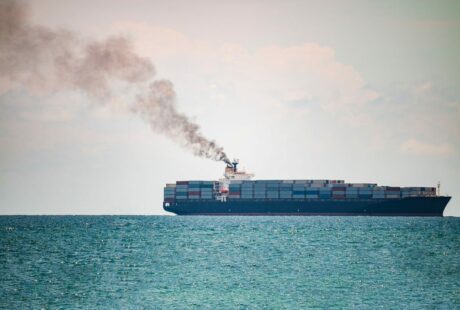The 2021 surge in greenhouse gas emissions from shipping gives away the sector’s empty climate promises and puts achieving the 1.5°C planet-heating target at an even greater risk.
Emissions from the international shipping sector increased by 4.9% in 2021, according to the newly published annual outlook of the world’s largest independent shipbroker, Simpson Spence and Young, leaving outright emissions even higher than their 2019 pre-pandemic levels.
This is in spite of the industry lobby groups portraying themselves as climate leaders at the COP26 climate summit, and claiming to support greater climate ambition.
Liquified Natural Gas (LNG) carriers saw the highest rise in emissions of any shipping segment in 2021, according to the same report, even while some shipping lines like CMA-CGM and MSC continue to misleadingly tout LNG as a “bridge fuel” or solution to the climate crisis.
Shipping must halve its emissions by 2030 and fully decarbonise by mid-century to keep the Paris Agreement targets within reach. The International Maritime Organization (IMO) must therefore respond by immediately revisiting and strengthening its recently agreed short-term GHG measure, as well as agreeing without delay a package of ambitious mid-term measures, including a carbon levy and a fuel standard, to reverse the growing trend. The agency must also urgently commit to full decarbonisation of shipping well before 2050.
John Maggs, Senior Policy Advisor, Seas at Risk, said: “The shipping industry has resisted every attempt to restrict sailing speeds, one of the most effective ways of controlling ship climate impacts, and now we know why. As soon as there’s money to be made they hit the gas pedal and couldn’t care less about the environment or our rapidly collapsing climate. Governments must stop listening to the reckless and irresponsible shipping industry and instead start setting legally binding measures and ship climate targets based on science and designed to stop runaway climate change” ”
Lucy Gilliam, Senior Policy Officer, Seas at Risk, said: “To maintain any chance of keeping warming below the Paris Agreement’s target of 1.5°C, ship emissions have to halve by 2030 and reach zero in the 2040s. This means a 6-7% annual improvement in their carbon intensity starting immediately. That the shipping industry has instead allowed their emissions to balloon is shocking.”
The rise in shipping emissions is linked to shipowners speeding up vessels to maximize profits during the current freight rates surge, and to a record number of vessels waiting at major ports. Container ships on the Asia to US route are speeding up as much as 22% faster in good weather, and consuming more fuel in the process, according to METIS, a Greek company that analyzes data on ship movement.
The shipping sector is not aligned with the climate goals of the Paris Agreement. The IMO’s current goal is to only halve shipping emissions by 2050. This lack of climate ambition has been publicly criticised for years by the climate community as well as by the UN’s own Secretary General, António Guterres, last year.
While the latest IMO climate talks, the “MEPC 77” in November 2021, showed growing support for the zero-emissions by 2050 target among the IMO member states, no agreement has yet been reached on revising the agency’s current weak target. Proposals for mid-term measures, including a $100-per-tonne carbon levy and a greenhouse gas standard for shipping fuels, were discussed in vague terms with no sense of urgency. The latest annual emissions data demonstrates the need for real leadership from all country delegates at IMO to get a grip on the situation.
Posted on: 28 January 2022



